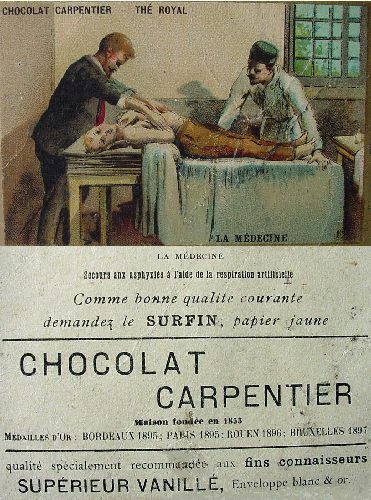|
At the beginning of the 20th century, the French chocolate factory CARPENTIER participated in the vulgarization of basic medical knowledge. In the picture, the patient lies in an overstretched supine position, the doctor or helper makes with his arms a kind of wing movement. This overstretching of the body is in contradiction to an ancient method (18th century), to awaken the drowned to life: they tied them belly down (!) On a barrel that you rolled back and forth ...
Although an imperial patent by Maria Theresa dated July 1, 1769, already gave the "instruction" on how to "sustain the seemingly drowned, stupid, or suffocated human beings," and recommended "to close the nostrils and keep the air strong and sustained to blow one's mouth ", this modern-looking instruction fell into oblivion. Until the mid-1950s, the method of chest compression described by Henry Robert Sylvester (1828-1908) in 1859 was the method of choice. A direct ventilation of the lungs was not carried out. It was the Austrian Peter SAFAR (1924 to 2003) who scientifically examined the breath in the USA in 1954 through mouth-to-mouth resuscitation. A method that midwives have been successfully using on newborns since the 16th century. His results were excellent and the new method quickly gained worldwide acceptance. Since approximately 1958, this form of oral or oral mouth-to-mouth contraception, in combination with external chest compressions, has been successfully used in resuscitation and taught in each first aid course. Peter Safar is now considered the father of Cardio Pulmonary Resuscitation (CPR).
The history of the revival
* 1744 First resuscitation of a miner by mouth-to-mouth resuscitation by the surgeon TOSSACH,
* 1847 manual ventilation by v. HASSELT,
* 1858 improved manual ventilation by SYLVESTER. The tongue was pulled out of the mouth and tied to the chin by a neck knot.
* Following the so-called Sylvester breathing exercise, the methods followed SCHÄFER and
* In 1871 the HOWARD method: the rescuer knelt astride the victim lying on his stomach with his face turned to the side, placing his hands on his lower ribs so that his thumbs were parallel and touching each other. Then a strong pressure was applied, which was slowly withdrawn so that the hands remained on the back.
* In 1938, the stretching of the thorax was added in a lateral position after KOHLRAUSCH.
Presented is a 8x5 cm card, bought on 22.4.2006 at a flea market in Steinfort - recto (above), verso (below). It comes from the series "La médecine" by the chocolate manufacturer Carpentier, with a revival scene "Respiration artificielle". The basic evil is described on the map as "asphyxia", as "suffocation". No distinction is made between suffocation caused by drowning, carbon monoxide poisoning, poisoning, etc. Carpentier had his large advertisements designed by Henri GERBAULT (1863-1930). Whoever drew the small collection pictures (fashion, etc.), we do not know.
|




